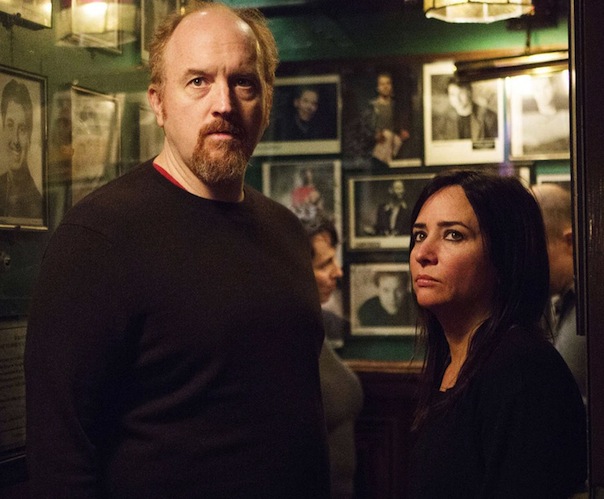Television Review: “Louie” at Season Four — Art House TV
Louie is a difficult show to advertise because it is the only example of art-television at the moment.
Throughout this past season, many people – some who really ought to know better – still expected Louie to fit the standard comedy show mold. Granted, most regular viewers value Louis C.K.’s idiosyncratic delivery of his generally funny observations of everyday life. But even after complex episodes such as “God,” “Dad,” and the “Late Show” trilogy, they anticipated being served up something hilarious, even gut-busting. The truth is, only a handful of the show’s episodes are laugh-out-loud hilarious, and the majority of them were in the first season. Louie hasn’t just been about laughs for a while. Viewers who want to roll on the floor should seek out Louis C.K.’s stand-up routine instead.
That being said, I can’t completely blame those coming to the show expecting a relatively straightforward farce – it’s marketed as a comedy (sometimes as a “dramedy”). It is a difficult show to advertise because really it is the only example of art-television at the moment. I’d even argue that it has been the only one (at least to have notable success) since Twin Peaks, which aired about 25 years ago. So it was fitting that director David Lynch guest-starred in two episodes of the abovementioned “Late Show” arc.
In the past couple of decades, television programs such as The Wire, Breaking Bad, and True Detective have been labeled as “art” by critics and fans. But I am not convinced. Yes, they are quality, prestige programs, but they are not “artistic” in the same sense that art house movies have been understood to be cutting edge — challenging and genre-stretching. Louie is. In his fourth season, C.K. even seems to be playing to an art house crowd – to the point of casting avant-garde musician Eszter Balint (also known for her performance in Jim Jarmusch’s indie classic Stranger Than Paradise) as his love interest in the six-part “Elevator” arc. This season C.K. is coming on like a French New Wave director, a self-conscious auteur. A realistic storyline and savory punchlines are no longer the focus — ideas and stylization predominate.
This season Louie has been moving into new and significant territory but it is not receiving the recognition it deserves. For instance, the internet wasn’t up-in-arms over the borderline rape scene in “Pamela Part 1,” despite its shock value, particularly C.K.’s slasher movie-esque treatment. Instead, folks were outraged by a Jaime-Cersei scene in Game of Thrones, a show that specializes in violence and sexual misconduct. The only scene from Louie this season that got much attention was Vanessa’s protracted monologue at the end of “So Did the Fat Lady,” for which actress Sarah Baker was nominated for a Critic’s Choice Television Award, with hopefully more accolades to come. I’ll bet Woody Allen’s jaw dropped when he saw the way C.K. handled that sequence – making the wise decision of keeping the drifting camera on Vanessa for the majority of the scene’s seven-and-a-half minutes. On that note, kudos must go to Slate for its terrific article on this season’s long takes, a piece that goes on to call Louie the “most cinematic show on TV.”
Season 4 was Louie’s most unified season for a number of reasons. One is the innovative order of the show’s story structure: after three isolated episodes, the series presented a six-part storyline, which was followed by the initial episode of a trilogy. Then came what was essentially a TV movie before there was a move back to the next two episodes of the trilogy. It sounds like chaos, but FX aired two episodes every Monday so it was a refreshingly novel way to experience a program’s sequencing. And because C.K. was dealing with such an ambitious story structure, he worked harder at maintaining narrative continuity than he had previously. After “So Did the Fat Lady,” the third episode, each one carried on from what had gone on before. He deviated from this scheme slightly by opting to air the extra-long “In the Woods” after “Pamela Part 1. ” But I suspect that maneuver was intentional, a way to build suspense for the trilogy.
What made this season a particularly fulfilling experience was its steady stream of dexterously arranged symbols and leitmotifs. The vibrator in the opening episode (“Back”) established the season’s theme of gender roles. Or the joint (“In the Woods”) that challenged Louie to consider what it really means to be a man (he is the father of two girls) after his gross action in the previous episode. You can choose to see Dr. Bigelow’s three-legged dog as a symbol of life’s unfairness, or of perseverance, or as a reflection of Louie, a hopeless romantic who is being chewed up by the way things are. Dogs were mentioned a lot this season; I don’t quite know what’s up with “I’m looking for a dog” guy in “Elevator Part 6.” Maybe it’s another instance of an inability to communicate, a problem Louie has with his ex-wife and Hungarian girlfriend.
But it is OK to relax and not wonder about what things mean in Louie. Make of the imagery what you will, C.K. seems to be saying. The nonsensical news broadcasts on hurricane Jasmine Forsythe throughout “Elevator” or the radio report on the assassination of Martin Luther King Jr. in “In the Woods” could be seen as nothing more than absurd background noise, or as comments on just how absurd life can be. Regardless of which interpretation you pick, this season C.K. was interested in conflating reality and fantasy. In “In the Woods,” a boy in Louie’s chemistry class asks if you fart in real life when you fart in a dream, which reminded me of the way the season opened: Louie is woken up by a bunch of garbage men who break into his bedroom and then destroy it.
How do I interpret this season of Louie? I see it as a deconstruction of a romantic perspective. Louie is a hopeless humanist trying to reconcile his ideals with the destructive might of the detached modern world. But that’s me. Maybe the breakdown of communication intrigued you more, or maybe the blurring of reality and dreams. Louie has been called the “real show about nothing,” but it’s more like the “show about anything.” And that is what makes it so groundbreaking and captivating — it depicts the subjective nature of everyday life, the uncertainty about what means what even though you are stuck having to make choices. Not since Twin Peaks has a TV program been as profound and as exciting.


